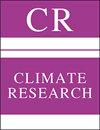Spatio-temporal changes of heat and cold wave patterns in western Iran
IF 1.6
4区 地球科学
Q4 ENVIRONMENTAL SCIENCES
引用次数: 0
Abstract
ABSTRACT: In this study, we investigated recent changes in frequency, intensity, and duration of heat waves and cold waves in western Iran, a semi-arid region where agricultural activities represent the major contribution to the region’s economy. Our results show that heat waves have become significantly more frequent, longer, and more intense since the end of the 20th century, while cold waves have behaved in the inverse way. Through a detailed synoptic analysis, we found that the action centers derived from the expansion of the Azores high pressure over the Arabian Desert and the Iranian plateau were mainly responsible for all heat waves. However, cold waves responded to 4 different patterns, of which the Siberian high pressure was the main atmospheric configuration leading to the most intense and persistent events.伊朗西部热浪和寒潮模式的时空变化
摘要:在这项研究中,我们调查了伊朗西部热浪和寒潮的频率、强度和持续时间的近期变化,该地区属于半干旱地区,农业活动对该地区的经济做出了重大贡献。我们的研究结果表明,自 20 世纪末以来,热浪的频率、持续时间和强度都明显增加,而寒潮的表现则相反。通过详细的同步分析,我们发现亚速尔群岛高压在阿拉伯沙漠和伊朗高原上空扩张所产生的作用中心是所有热浪的主要原因。然而,寒潮对 4 种不同的模式做出了反应,其中西伯利亚高压是导致最强烈和最持久事件的主要大气配置。
本文章由计算机程序翻译,如有差异,请以英文原文为准。
求助全文
约1分钟内获得全文
求助全文
来源期刊

Climate Research
地学-环境科学
CiteScore
2.90
自引率
9.10%
发文量
25
审稿时长
3 months
期刊介绍:
Basic and applied research devoted to all aspects of climate – past, present and future. Investigation of the reciprocal influences between climate and organisms (including climate effects on individuals, populations, ecological communities and entire ecosystems), as well as between climate and human societies. CR invites high-quality Research Articles, Reviews, Notes and Comments/Reply Comments (see Clim Res 20:187), CR SPECIALS and Opinion Pieces. For details see the Guidelines for Authors. Papers may be concerned with:
-Interactions of climate with organisms, populations, ecosystems, and human societies
-Short- and long-term changes in climatic elements, such as humidity and precipitation, temperature, wind velocity and storms, radiation, carbon dioxide, trace gases, ozone, UV radiation
-Human reactions to climate change; health, morbidity and mortality; clothing and climate; indoor climate management
-Climate effects on biotic diversity. Paleoecology, species abundance and extinction, natural resources and water levels
-Historical case studies, including paleoecology and paleoclimatology
-Analysis of extreme climatic events, their physicochemical properties and their time–space dynamics. Climatic hazards
-Land-surface climatology. Soil degradation, deforestation, desertification
-Assessment and implementation of adaptations and response options
-Applications of climate models and modelled future climate scenarios. Methodology in model development and application
 求助内容:
求助内容: 应助结果提醒方式:
应助结果提醒方式:


